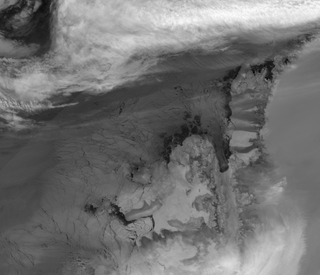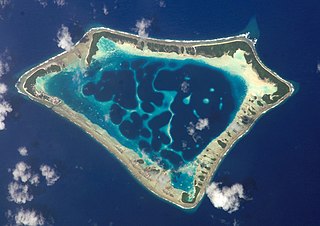
The history of Antarctica emerges from early Western theories of a vast continent, known as Terra Australis, believed to exist in the far south of the globe. The term Antarctic, referring to the opposite of the Arctic Circle, was coined by Marinus of Tyre in the 2nd century AD.

The Weddell Sea is part of the Southern Ocean and contains the Weddell Gyre. Its land boundaries are defined by the bay formed from the coasts of Coats Land and the Antarctic Peninsula. The easternmost point is Cape Norvegia at Princess Martha Coast, Queen Maud Land. To the east of Cape Norvegia is the King Haakon VII Sea. Much of the southern part of the sea is covered by a permanent, massive ice shelf field, the Filchner-Ronne Ice Shelf.

Elephant Island is an ice-covered mountainous island off the coast of Antarctica in the outer reaches of the South Shetland Islands, in the Southern Ocean. Its name was given by early explorers sighting elephant seals on its shores. The island is situated 245 kilometres north-northeast of the tip of the Antarctic Peninsula, 1,253 kilometres west-southwest of South Georgia, 935 kilometres south of the Falkland Islands, and 885 kilometres southeast of Cape Horn. It is within the Antarctic claims of Argentina, Chile and the UK. Brazil has a shelter on the island, Goeldi, supporting the work of up to six researchers each during the summer and had another (Wiltgen), which was dismantled in the summer of 1997/98.

Berkner Island is an Antarctic ice rise, where bedrock below sea level has caused the surrounding ice sheet to create a dome. If the ice cap were removed, the island would be under water. Berkner "Island" is high and completely ice-covered and about 320 kilometres (200 mi) long and 150 kilometres (93 mi) wide, with an area of 44,000 km2 (17,000 sq mi). It is surrounded by the Filchner-Ronne Ice Shelf. The northernmost point of the Berkner is about 20 kilometres (12 mi) from the open sea. It lies in the overlapping portion of the Argentine and the British Antarctic territorial claims.

Shackleton Ice Shelf is an extensive ice shelf fronting the coast of East Antarctica for about 384 km, projecting seaward about 145 km in the western portion and 64 km in the east. It occupies an area of 33,820 km². It is part of Mawson Sea and separates the Queen Mary Coast to the west from the Knox Coast of Wilkes Land to the east. The existence of this ice shelf was first made known by the USEE under Charles Wilkes who mapped a portion of it from the Vincennes in February 1840. It was explored by the Australian Antarctic Expedition under Douglas Mawson (1911–14) who named it for Sir Ernest Shackleton. The extent of the ice shelf was mapped in greater detail in 1955, using aerial photography obtained by US Navy Operation Highjump, 1946-47. Further mapping by the Soviet Expedition of 1956 showed the portion eastward of Scott Glacier to be a part of this ice shelf.

Bowman Island is a high ice-covered island, about 39 kilometres (24 mi) long and from 3 to 10 kilometres wide, shaped like a figure eight. Bowman Island is located at 65°16′48″S103°6′36″E. Bowman Island rises above the northeastern part of Shackleton Ice Shelf, which partially encloses the island, 40 kilometres (25 mi) northeast of Cape Elliott. Discovered on January 28, 1931, by British Australian and New Zealand Antarctic Research Expedition (BANZARE) under Sir Douglas Mawson, who named it for Isaiah Bowman, then Director of the American Geographical Society.

Charcot Island or Charcot Land is an island administered under the Antarctic Treaty System, 56 kilometres (30 nmi) long and 46 kilometres (25 nmi) wide, which is ice covered except for prominent mountains overlooking the north coast. Charcot Island lies within the Bellingshausen Sea, 102 kilometres (55 nmi) west of Alexander Island, and about 57 kilometres (31 nmi) north of Latady Island. A notable landmark of the island is its northernmost point, Cape Byrd.

The Dailey Islands are a group of small volcanic islands lying off the coast of Victoria Land, 9 kilometres (5 nmi) northeast of Cape Chocolate, in the northern part of the ice shelf bordering McMurdo Sound. They were discovered by the British National Antarctic Expedition, 1901–04, under Robert Falcon Scott, and named for Fred E. Dailey, the expedition carpenter.

Denman Glacier is a glacier 7 to 10 nautical miles wide, descending north some 70 nautical miles, which debouches into the Shackleton Ice Shelf east of David Island, Queen Mary Land. It was discovered in November 1912 by the Western Base party of the Australasian Antarctic Expedition under Sir Douglas Mawson. Mawson named the glacier for Lord Denman, Governor-General of Australia in 1911, a patron of the expedition.

Anton Island is a low ice-capped island about 1 kilometre (0.5 nmi) long. It lies 9 kilometres (5 nmi) north-northeast of Lewis Island, just outside the east side of the entrance to Davis Bay. It was discovered in 1956 from the MV Kista Dan by an Australian National Antarctic Research Expedition led by Phillip Law that landed on the island on 18 January 1960, and was named by the Antarctic Names Committee of Australia for Anton Moyell, first officer on the MV Magga Dan in 1960.

Blåskimen Island is a high, ice-covered island about 15 kilometres (8 nmi) north of Novyy Island, at the juncture of the Jelbart Ice Shelf and the Fimbul Ice Shelf, Queen Maud Land. The island rises about 300 metres (1,000 ft) above the general level of the ice shelf and is surrounded by this ice, except for the north side which borders the sea. The feature was roughly delineated by Norwegian cartographers working with air photos taken by the Norwegian–British–Swedish Antarctic Expedition in 1951–52 and the Sixth Norwegian Antarctic Expedition in 1958–59. They called the island Blåskimen and included the area now called Novyy Island. The Soviet Antarctic Expedition mapped the feature in 1961 and showed it to be separated from Novyy Island.

Buffer Island is a mostly ice-covered island lying west of the Wordie Ice Shelf, 17 kilometres (9 nmi) northwest of Mount Balfour, Fallières Coast. The feature was photographed from aircraft by the Ronne Antarctic Research Expedition in 1947. Following survey by the Falklands Islands Dependencies Survey in 1958 it was named "Buffer Ice Rise" by the UK Antarctic Place-names Committee (UK-APC) because it obstructed the northwestward flow of the ice shelf in this vicinity. The UK-APC amended the name to Buffer Island following a general eastward recession of the Wordie Ice Front in about 1999, which disclosed the feature to be an island.

Vollmer Island is an ice-covered island 20 kilometres (11 nmi) long, lying along the edge of Sulzberger Ice Shelf, 13 kilometres (7 nmi) northwest of Cronenwett Island. It appears that this feature was first observed and roughly mapped from aerial photographs taken by the Byrd Antarctic Expedition, 1928-30. Named by Advisory Committee on Antarctic Names (US-ACAN) for Lieutenant T.H. Vollmer, U.S. Navy, engineering officer aboard USS Glacier along this coast, 1961-62.

The White Islands are a group of ice-covered islands extending north-south for about 19 kilometres (10 nmi). They lie at the east margin of Swinburne Ice Shelf and near the terminus of Butler Glacier in the south part of Sulzberger Bay. This feature is rudely delineated on the map of the Byrd Antarctic Expedition, 1928–30, as "low ice cliffs" that rise above the level of the ice shelf. The islands were mapped in detail by United States Geological Survey (USGS) from surveys and U.S. Navy air photos, 1959-65. The name was applied by Advisory Committee on Antarctic Names (US-ACAN) at the suggestion of Admiral R.E. Byrd. Named for Dr. Paul Dudley White, internationally renowned specialist on heart diseases, who was a consultant on medical matters in regard to U.S. Navy Operation Highjump, 1946–47, led by Byrd.

Johnson Island is an ice-covered island, about 17 kilometres (9 nmi) long and 9 kilometres (5 nmi) wide, lying within the Abbot Ice Shelf, Antarctica, about 26 kilometres (14 nmi) southeast of Dustin Island. The feature was observed and roughly positioned as an "ice rise" by parties from the USS Glacier (AGB-4) in February 1961. It was remapped by the United States Geological Survey from U.S. Navy air photos, 1966, and was named by the Advisory Committee on Antarctic Names for Theodore L. Johnson, an electrical engineer at Byrd Station in 1964–65.

Dodd Island is a small island in the southeast part of the Publications Ice Shelf about 20 kilometres (10 nmi) south of the Sostrene Islands. First mapped by the Lars Christensen Expedition (1936–37) from air photos, it was remapped by the Australian National Antarctic Research Expeditions, and was named by the Antarctic Names Committee of Australia for D.M. Dodd, a weather observer at Davis Station in 1963.

Mousinho Island is a partly ice-covered island, 235 m high, about 3.7 kilometres (2 nmi) from the south end of Gillock Island in the Amery Ice Shelf. Photographed by U.S. Navy Operation Highjump (1946–47) and ANARE (1958). First visited by a party led by J. Manning, from the ANARE Prince Charles Mountains survey in January 1969. Named by Antarctic Names Committee of Australia (ANCA) for A. Mousinho, pilot of the Beaver aircraft with the 1969 ANARE Prince Charles Mountains party.

Single Island is a high ice-covered island on the west side of the Amery Ice Shelf about 26 kilometres (14 nmi) south of Landon Promontory. First plotted by ANARE from air photos taken in 1956, but incorrectly shown as a promontory. Later mapped by ANARE as an island. Named by Antarctic Names Committee of Australia (ANCA) for M. Single, senior diesel mechanic at Mawson Station in 1962, a member of the ANARE field party which visited the area in December 1962.













